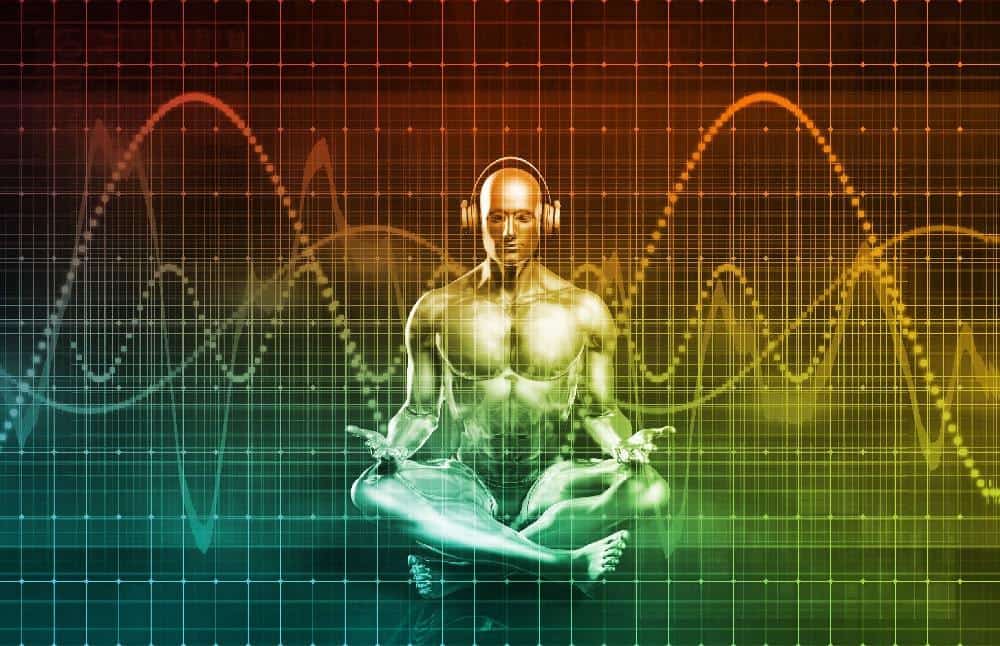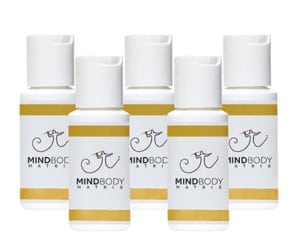
Do you often listen to your favorite song or go outdoors to listen to the sounds of nature when you feel stressed or anxious? Does it calm and relax you?
A lot of people turn to music or sounds to release their tension and anxiety.
But do you know that there is a particular sound wave that can effectively reduce your anxiety levels?
They are the binaural beats for anxiety or audio files with sound waves that induce ‘brain entrainment.’
A meta-analysis on their efficacy showed positive effects on cognition and in reducing anxiety levels and pain perception.
What Are Binaural Beats?
Binaural beats are technically the difference between the sounds that you receive in your left ear and right ear.
For example, your right ear registers a frequency of 150 Hz and your left ear receives a frequency of 140 Hz.
The difference, which is 10 Hz, is the binaural beat perceived by the brain as a single noise.
The discovery of this soundwave phenomenon was attributed to Heinrich Wilhelm Dove, a Prussian meteorologist who noticed that a subtle difference between two tuning forks that he placed on opposite sides of a room.
There was one slow beat that he called the binaural beat. His work was published in 1839.
But it was only in 1973 or more than a hundred years after it was discovered, that the curiosity about binaural beats became a serious point of interest when Dr. Gerald Oster observed that people’s perception of these sounds varies.
He also noticed that those with neurological conditions do not perceive binaural beats. Seeing the potential, he explored them as a diagnostic tool and published the article entitled ‘Auditory Beats in the Brain.’
His work provided new insights about binaural beats and supported Dove’s research.
It also started a revolutionary change in the field of neurophysiology as neurophysiologists became more interested in finding more about the sense of hearing.
Since the rediscovery, binaural beats have been used to reduce pain, trigger lucid dreaming, improve and unlock creative juices.
They have become a form of brain entrainment technology because of their potent ability to alter the state of consciousness or influence the brain waves.
They are also used as an intervention to cure hyperacidity, improve the sexual experience, intelligence booster, and meditation aid.

Lucid Dreaming – FREE masterclass
How Do Binaural Beats Work?
Interested to learn more on Silva System? Joint FREE Masterclass today!
“Binaural” literally means “both ears.” These auditory illusions are produced by two different frequencies that the ears received, pulsating deep inside the brain.
It cannot be detected by the conscious mind but the brain perceives it as real. So, how do binaural beats work to ease anxiety?
Binaural beats from 1-30 Hz are believed to induce a meditative state that is associated with reducing stress and anxiety.
Binaural beats for anxiety are in the theta frequencies or the alpha range.
- Binaural beats in the Theta frequencies (4-8 Hz) are associated with REM sleep, relaxation, reduced anxiety, meditative state, and creative state
- Binaural beats in the Alpha range (8-13 Hz) can induce relaxed focus, reduce stress, and encourage positive thinking and learning
Other binaural beats for various purposes are:
- Binaural beats in the Delta range (1-4 Hz) are beneficial for relaxation and deep sleep
- Binaural beats in the Beta frequencies (14-30 Hz) are believed to improve memory, increase alertness and concentration, and enhance the ability to solve problems
The binaural beats concept is also similar to music, stimulating changes in some neuro-activities that help to ease anxiety symptoms.
There are musical tracks or audio files that easily trigger shifts in the brain waves, directly influencing cognition and mood conditions.
As you listen to the binaural beats, the activity of your brain matches the sounds’ frequency.
This is known as the frequency-following effect, letting you entrain your mind by listening to binaural beats.
The synchronization of the brain’s activities is called entrainment.
It is done by the superior olivary complex part of the brain, the brain stem that processes the sounds coming from both ears.
Once this complex part perceives two close sound frequencies, it automatically produces binaural beats, changing the pattern of brain waves.
What Benefits Do You Get From Binaural Beats?

Based on several studies and experiments conducted to back up the therapeutic claim, it looks like binaural beats are a beneficial option to fight stress, anxiety, and other negative emotions that can cause mental disorders.
- Listening to audio tracks or CDs of binaural beats brings positive effects on anxiety level, mood, attention, creativity, and memory
- They help people with insomnia to fall asleep. This is because binaural beats in 4 Hz frequency (border between delta and theta) are similar to the brain’s border between asleep and awake

- They help you sleep better as they can produce low-frequency sounds that slow down the activities of the brain and induce sleepiness
- They can significantly improve long-term memory due to beta pattern frequency exposure as presented by a 2019 study
- They increase motivation, attention, focus, and confidence
- They enhance psychomotor performance
- They help to induce better meditation
- They can distract you from pain and aid in managing it
However, they may not work for some people and are not recognized as a cure to treat a particular condition.
Studies about their clinical benefits are inconclusive, so binaural beats are not used to replace the traditional treatments for anxiety.
How to Use Binaural Beats
Want to know what else you can learn with Mindvalley membership? Watch FREE Masterclass now!
To harness the benefits of binaural beats, you need an MP3 or any device that plays music and a pair of headphones or earphones.
Choose a binaural beat audio material that resonates with you or fits your purpose. There are many available online binaural beats music on Spotify or YouTube.
You can also download them from CDs to your MP3 player or smartphone. You can also purchase them online.
Listen to the sounds for about 30 minutes. This helps synchronization or ensure that the rhythms are entrained throughout your brain.
Find a comfortable, distraction-free area and allow the beats to ease your anxiety. You can choose to close your eyes or not when listening to the binaural beats.
As you practice more, you can vary the listening time to find out what works great for you. You can listen longer if you are experiencing a high level of anxiety or shorter as needed.
For meditation:
If meditation is your way to ease anxiety attacks, you can incorporate the binaural beats to get you into the ‘meditative’ state deeper than usual, enhancing your experience as you seek grounding, balance, and healing.
They also come in handy in facilitating this state for people who are struggling with traditional, unassisted meditation.
The binaural beats help in quieting the mind to achieve the necessary mental state by capturing the brainstem’s attention away from the neocortex, the brain part where all the thinking processes happen.
Are Binaural Beats Safe?
While there are no potential dangers when you regularly listen to binaural beats, it is important to follow the instructions of the producer of these sounds.
- Avoid listening to very loud tones. Binaural beats that are over 85 decibels, which is equal to the sound of heavy traffic, can cause hearing impairment in the long run
- Do not listen to binaural beats while you are doing tasks that involve full attention and alertness like driving, operating large and heavy machinery, or working. The sounds can put you in a trance-like mental state and can compromise your safety
People with the following conditions should be careful or take their doctor’s advice before listening to binaural beats:
- Epileptic people because the change in the brain waves may trigger seizure attacks
- People with pacemakers or suffering from heart conditions because heart rhythms are influenced by the brain waves. Any slight change can lead to serious troubles
- People with psychological or mental disorders and those taking tranquilizers
- Pregnant women should refrain from listening to binaural beats because the brain wave entrainment can stimulate labor
- Children should not be given binaural beats therapy because they still have an immature brain and are at a higher risk to develop a seizure disorder
Can Binaural Beats Help With Anxiety?

World Health Organization (WHO) reports that 1 in 13 people across the globe suffers from anxiety, which is 3.6% or 254 million people and still counting. This makes therapies of all kinds very much in demand.
Several studies show binaural beats, which some experts call ‘acoustic beats’ or ‘physical phenomenon’, change the brain’s functional connectivity (Karino et al. 2004; Karino, 2006, Gao et all., 2014)
In Montreal, Quebec, a case study revealed that participants who listened to recorded tracks using binaural beats 5 days a week in one month resulted in the reduction of anxiety attacks based on their daily diaries.
The tapes used for this experiment contained binaural beats in the delta and theta range.
An exposure of at least 10 minutes to 6 Hz frequency (theta frequency) puts the brain in a meditative state.
In another study, patients in a psychiatric ward were instructed to listen to binaural beats for at least 20 minutes a day for two weeks.
The outcome showed that there was a 26% reduction in anxiety.
Binaural Beats for Anxiety: Final Note

Binaural beats for anxiety are created to help people who are seeking a safe and easily accessible way to conquer the symptoms and live a better life.
Related Posts:
Natural Remedies For Anxiety And Depression – 14 Home Treatments Without Medication
How Can Having a Holistic View Help You Become a Better Person?
Why Stress Poses a Threat to Quality of Life? (4 Main Threats Explained!)
Natural Healing Methods – 7 Holistic Therapies Proven to Work
How To Use Lofty Questions to Manifest a Better Reality
Emotional Release Technique: Master Your Emotions With Tapping!







Heya! hope you doing good and doing some amazing job writing these type of blogs
Thank you, glad to hear it. Enjoy it!